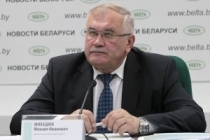Ru
|
Eng
Mikhadyuk: Belarusian NPP in compliance with Espoo Convention
03.03.2016

The Belarusian NPP complies with the requirements of the Espoo Convention, Belarusian Deputy Energy Minister Mikhail Mikhadyuk said in an interview with the Lithuanian newspaper Lietuvos Rytas, BelTA has learned.
When asked to comment on the claims alleging that it is not in compliance with the Espoo Convention, Mikhail Mikhadyuk said: “Those who say this have probably never read the Convention.”
This multilateral international agreement regulates the interaction between countries in the situation when one country is planning to undertake an activity which can have a negative impact on the environment in another country. The Convention does not provide for any specific requirements to nuclear power plants.
The procedure of interaction envisaged in the Convention includes several stages. The party of origin needs to prepare a report on the environmental impact assessment of the projected facility, discuss this report with the concerned party at the level of government officials and experts, in the format of public consultations. Claims and proposals that are put forward during such discussions should be taken into consideration when making a final decision.
The environmental impact assessment report regarding the Belarusian NPP was prepared in 2009 and submitted to the concerned parties in 2010. International consultations to discuss the report took place in Austria, Latvia, Lithuania, Poland, and Ukraine in 2010. There were public consultations in Austria, Lithuania, and Ukraine. The report was revised taking into account all the claims and proposals, and the final report on the environmental impact assessment of the Belarusian NPP was submitted to the concerned parties and the Espoo Convention Secretariat in February 2011. All countries involved, except for Lithuania, were satisfied with the results of the discussions.
“Taking into account Lithuania’s complaint to the Espoo Convention, we submitted the text of the EIA report on the environmental impact translated into Lithuanian to the Lithuanian side in 2013. In fact, Lithuania received the report three times: the preliminary version and the final version which had been revised taking into account all the claims and proposals were provided in English, and the final version – in Lithuanian,” Mikhail Mikhadyuk reminded.
In summer 2013, the Belarusian side proposed the Lithuanian government to hold consultations with the general public and Lithuanian government officials in Vilnius. “Unfortunately, the Lithuanian side preferred the tactics of procedural tricks aimed at delaying our final decision regarding the construction of the NPP. In this situation we organized a meeting with Lithuanians in Ostrovets. I took part in that meeting. It was held in the form of full-fledged public consultations with numerous topical issues on the agenda. A full video recording of the event is available in the Internet. By the way, we invited Lithuanian experts, representatives of ministries and MPs to the meeting, but they never showed up,” the deputy minister said.
“In 2014, we prepared and submitted the so-called post-project analysis program to the abovementioned five concerned parties. In accordance with this program, Belarus collects the data of the environmental and radiation monitoring and submits the information to the participants of the program in order to make a joint transparent assessment of the conclusions regarding the environmental impact of the NPP. The only country which is still not working with us on the program is Lithuania,” Mikhail Mikhadyuk said.
“It means that Belarus has fulfilled its obligations within the framework of the Convention, while the Lithuanian side continues using ‘the broken record’ method and simply ignores the objective reality,” he concluded.
ANALYTICS
30.08.2023
21.03.2023
30.08.2021
02.07.2021
23.06.2021
10.06.2021
04.06.2021
03.06.2021
20.05.2021
15.05.2021













